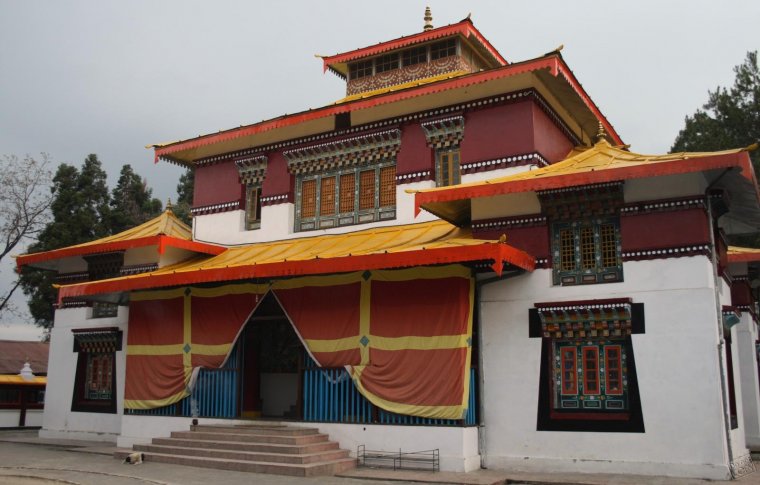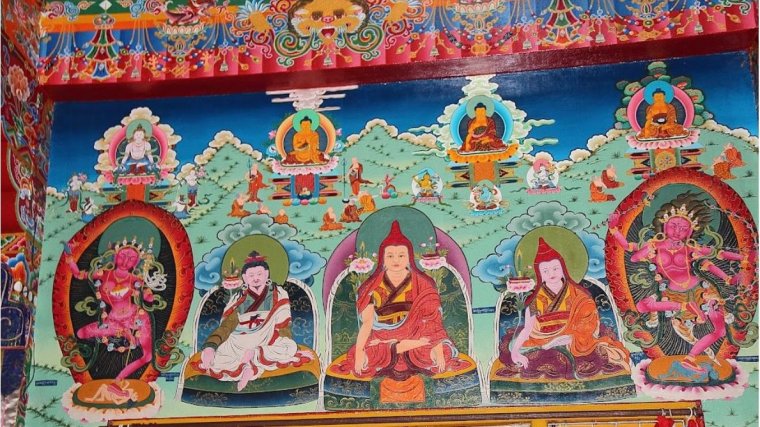| Published in Attractions / Temples, Ashrams, Monasteries |
Enchey Monastery, Sikkim, India
Nyingma Tradition, 19th century, about 90 monks.
The Enchey Sangag Rabtenling Monastery or simply Enchey Monastery is located near Gangtok, the capital city of Sikkim. It belongs to the Nyingma order of Vajrayana Buddhism.

Enchey Monastery. Photo: Kothanda Srinivasan, Wikipedia.
Location
History
The legend says that a monk named Chinyer Lama stayed in a cave at Mainam Hill, above Ralang Monastery. After meditating there for some time, he attained the stage of Drubthob or Siddha.
A hunter from Yangang village came across his cave and called him Drubthob Karpo (White Saint) and invited him to his home and asked for his blessings.
Chinyer Lama used his powers to reach the hunter’s house from Mainam Hill. The hunter built a small shrine in this place where Chinyer Lama spent some years and later entered in meditation at Taktse hilltop. Thereafter he went to Dromo in Tibet and then to Bhutan where he passed away.
Later, a hermit named Karma Sherab came to the shrine of Enchey for retreat. After few years, he acquired similar siddhis to his predecessor, Drubthob Karpo (Chinyer) Lama.
Thereafter, this place became more significant and the lineage holders of Drubthob Karpo developed the old Shrine into a full-fledged monastery in the year 1840, Enchey Monastery (Solitary Monastery), or ‘Sangngag Rabtenling’ (Sacred Stable Place), with 15 monks.
During the reign of 10th Chhogyal Sidkyong Tulku (1879-1914), the monastery was rebuilt in 1908 as an adaptation of Chinese Temple of Gyanak Riwo Tsenga.
According to other legends, the sacredness of the monastery is attributed to the belief that Khangchendzonga and Yabdean, the protecting deities, resided in this monastery after Guru Padmasambhava had subdued them.
In view of this legend, the religious significance of Enchey Monastery is deeply ingrained in every household in Gangtok. It is also believed that these powerful deities always fulfil the wishes of the devotees.
Features
The monastery is topped by a shining golden cupola. Worshipped in the monastery are the Buddha, Loki Sharia and Guru Padmasambhava.
The walls in the large prayer hall are covered with paintings and murals of four religious kings, the deities of the four cardinal directions as stated in the scriptures and the entire galaxy of Mahayana Buddhist deities. Manuscripts of scriptures are kept in an almirah.
Like all other Nyingma monasteries in Sikkim, this monastery is under the jurisdiction of the Pemayangtse Monastery and is home of 90 monks.
The monastery has a large collection of masks which are used for the annual ritual dances. As its name implies, monastery has a peaceful atmosphere and maintains a good library.

Enchey Monastery murals. Photo: Sanjit Kumar Bardhan
Festivals
• Detor Cham is the colorful and vibrant Cham dance festival that is held in the monastery during on the 18th and 19th day of the 12th Lunar month of the Tibetan calendar, corresponding to the dates during January/February of the Gregorian calendar.
Other festivals observed in the Enchey Monastery are:
• Singhe Cham performed once every three years.
• Pang Lhabsol commemorating the swearing of blood-brotherhood between the Bhutias and Lepchas in the presence of Khangchendzonga as witness.
The Cham dancers wear masks and ornate robes representing Mahakala (the protector) and mythical snow lions.
The dance festivals are usually held prior to the Losar, the Tibetan New Year day (February/March) and Losoong, the Sikkimese New Year (December/January).
Travel and Visiting
Enchey Monastery may be visited throughout the year, however December to March is recommended to experience the traditional dance festivals. Seek permission from monastery officials before taking photographs.
The nearest airport is that of Bagdogra in West Bengal. National Highway 31 A connects Gangtok with Kolkata, Siliguri, Darjeeling and Kalimpong. Regular bus services, jeeps and taxis are available between Gangtok and Siliguri.
Sources
• https://en.wikipedia.org/wiki/Enchey_Monastery
• http://www.sikkimeccl.gov.in/History/Monasteries/East/EncheyMonastery.aspx
• http://www.buddhist-temples.com/buddhist-monastery/sikkim/enchey-monastery.html
YOU MAY ALSO LIKE





 If you own or manage a travel-related business such as a hotel, a bed-and-breakfast, a restaurant, a pub or a cafeteria, you can create a web page for your business for free on Titi Tudorancea Travel Info. » |
